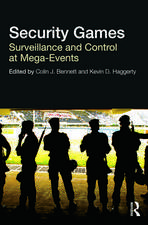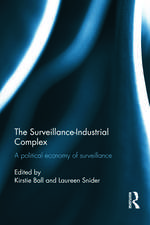Routledge Handbook of Surveillance Studies: Routledge International Handbooks
Editat de Kirstie Ball, Kevin Haggerty, David Lyonen Limba Engleză Paperback – 14 feb 2014
With a collection of over forty essays from the leading names in surveillance studies, the Handbook takes a truly multi-disciplinary approach to critically question issues of:
- surveillance and population control
- policing, intelligence and war
- production and consumption
- new media
- security
- identification
- regulation and resistance.
Din seria Routledge International Handbooks
-
 Preț: 371.78 lei
Preț: 371.78 lei -
 Preț: 375.50 lei
Preț: 375.50 lei -
 Preț: 362.20 lei
Preț: 362.20 lei -
 Preț: 352.09 lei
Preț: 352.09 lei - 9%
 Preț: 1487.73 lei
Preț: 1487.73 lei - 5%
 Preț: 317.32 lei
Preț: 317.32 lei -
 Preț: 372.05 lei
Preț: 372.05 lei -
 Preț: 361.20 lei
Preț: 361.20 lei -
 Preț: 390.14 lei
Preț: 390.14 lei -
 Preț: 311.91 lei
Preț: 311.91 lei - 9%
 Preț: 1488.70 lei
Preț: 1488.70 lei -
 Preț: 390.23 lei
Preț: 390.23 lei -
 Preț: 347.75 lei
Preț: 347.75 lei -
 Preț: 347.75 lei
Preț: 347.75 lei - 9%
 Preț: 1490.13 lei
Preț: 1490.13 lei -
 Preț: 356.23 lei
Preț: 356.23 lei -
 Preț: 348.29 lei
Preț: 348.29 lei - 5%
 Preț: 328.13 lei
Preț: 328.13 lei -
 Preț: 394.25 lei
Preț: 394.25 lei - 8%
 Preț: 392.90 lei
Preț: 392.90 lei - 8%
 Preț: 422.42 lei
Preț: 422.42 lei -
 Preț: 357.23 lei
Preț: 357.23 lei - 8%
 Preț: 421.97 lei
Preț: 421.97 lei - 5%
 Preț: 452.17 lei
Preț: 452.17 lei - 9%
 Preț: 1665.72 lei
Preț: 1665.72 lei - 9%
 Preț: 1651.64 lei
Preț: 1651.64 lei -
 Preț: 350.21 lei
Preț: 350.21 lei -
 Preț: 381.91 lei
Preț: 381.91 lei -
 Preț: 345.64 lei
Preț: 345.64 lei -
 Preț: 347.75 lei
Preț: 347.75 lei - 20%
 Preț: 1401.04 lei
Preț: 1401.04 lei -
 Preț: 342.77 lei
Preț: 342.77 lei -
 Preț: 346.78 lei
Preț: 346.78 lei -
 Preț: 345.17 lei
Preț: 345.17 lei -
 Preț: 353.89 lei
Preț: 353.89 lei -
 Preț: 1058.63 lei
Preț: 1058.63 lei -
 Preț: 348.06 lei
Preț: 348.06 lei - 5%
 Preț: 337.34 lei
Preț: 337.34 lei -
 Preț: 365.90 lei
Preț: 365.90 lei - 9%
 Preț: 1528.89 lei
Preț: 1528.89 lei -
 Preț: 346.12 lei
Preț: 346.12 lei -
 Preț: 392.49 lei
Preț: 392.49 lei - 9%
 Preț: 1454.53 lei
Preț: 1454.53 lei - 9%
 Preț: 1492.85 lei
Preț: 1492.85 lei - 5%
 Preț: 326.87 lei
Preț: 326.87 lei -
 Preț: 361.75 lei
Preț: 361.75 lei - 9%
 Preț: 1349.84 lei
Preț: 1349.84 lei - 19%
 Preț: 422.81 lei
Preț: 422.81 lei - 8%
 Preț: 385.56 lei
Preț: 385.56 lei
Preț: 473.30 lei
Preț vechi: 556.83 lei
-15% Nou
Puncte Express: 710
Preț estimativ în valută:
90.58€ • 94.21$ • 74.78£
90.58€ • 94.21$ • 74.78£
Carte tipărită la comandă
Livrare economică 14-28 aprilie
Preluare comenzi: 021 569.72.76
Specificații
ISBN-13: 9781138026025
ISBN-10: 1138026026
Pagini: 472
Ilustrații: 4
Dimensiuni: 174 x 246 x 30 mm
Greutate: 0.79 kg
Ediția:1
Editura: Taylor & Francis
Colecția Routledge
Seria Routledge International Handbooks
Locul publicării:Oxford, United Kingdom
ISBN-10: 1138026026
Pagini: 472
Ilustrații: 4
Dimensiuni: 174 x 246 x 30 mm
Greutate: 0.79 kg
Ediția:1
Editura: Taylor & Francis
Colecția Routledge
Seria Routledge International Handbooks
Locul publicării:Oxford, United Kingdom
Public țintă
Postgraduate and UndergraduateRecenzii
"This ground-breaking book contains over forty essays by some of the leading commentators on the burgeoning academic field of Surveillance Studies, covering most if not all of the critical challenges of surveillance and population control; policing, intelligence and war; the new social networking media; the emerging capacities of geo-location, identity recognition and real time tracking, as well as the thorny questions of future regulation and resistance, over a generous volume of some 437 pages.
Whilst there are other excellent Surveillance Studies readers, such as the work edited by Hier and Greenberg (2007), the formidable profile, diversity, breadth and scope of the Routledge collection, make it quite simply, definitive. Here we have authors such as James Rule, Gary Marx, David Lyon and Clive Norris—who essentially founded the field—mixed with new authors who take the insights of these pathfinders into new domains. The Handbook could not be more timely, as the pace of technological innovation in surveillance transcends many of the existing legal and cultural limits and understandings of its role and function." Steve Wright, Leeds Metropolitan University, UK
Whilst there are other excellent Surveillance Studies readers, such as the work edited by Hier and Greenberg (2007), the formidable profile, diversity, breadth and scope of the Routledge collection, make it quite simply, definitive. Here we have authors such as James Rule, Gary Marx, David Lyon and Clive Norris—who essentially founded the field—mixed with new authors who take the insights of these pathfinders into new domains. The Handbook could not be more timely, as the pace of technological innovation in surveillance transcends many of the existing legal and cultural limits and understandings of its role and function." Steve Wright, Leeds Metropolitan University, UK
Cuprins
Preface: ‘Your Papers Please’: Personal and Professional Encounters with Surveillance. Introduction: Introducing Surveillance Studies Part 1: Understanding Surveillance Part 1 Introduction 1.1. Theory 1: After Foucault 1.1.a. Panopticon – Discipline – Control 1.1.b. Simulation and Post-Panopticism 1.1.c. Surveillance As Biopower 1.2. Theory 2: Difference, Politics, Privacy 1.2.a. ‘You Shouldn’t Wear That Body’ – The Problematic of Surveillance and Gender 1.2.b. The Information State: A Historical Perspective on Surveillance 1.2.c. Needs For Surveillance and the Movement to Protect Privacy 1.2.d. Race and Surveillance 1.3. Cultures of Surveillance 1.3.a. Performing Surveillance 1.3.b. Ubiquitous Surveillance 1.3.c. Surveillance in Literature, Film and Television 1.3.d. Surveillance Work(ers) Part 2: Surveillance as Sorting Part 2 Introduction 2.1. Surveillance Techniques 2.1.a. Statistical Surveillance: Remote Sensing in the Digital Age 2.1.b. Advertising’s New Surveillance Ecosystem 2.1.c. New Technologies, Security and Surveillance 2.2. Social Divisions of Surveillance 2.2.a. Colonialism and Surveillance 2.2.b. Identity, Surveillance and Modernity: Sorting Out Who’s Who 2.2.c. The Surveillance-Industrial Complex 2.2.d. The Body as Data in the Age of Information Part 3: Surveillance Contexts Part 3 Introduction 3.1. Population Control 3.1.a. Borders, Identification, and Surveillance: New Regimes of Border Control 3.1.b. Urban Spaces of Surveillance 3.1.c. Seeing Population: Census and Surveillance By Numbers 3.1.d. Surveillance and Non-Humans 3.1.e. The Rise of the Surveillance School 3.2. Crime and Policing 3.2.a. Surveillance, Crime and the Police 3.2.b. Crime, Surveillance and the Media 3.2.c. The Success of Failure: Accounting For the Global Growth of CCTV 3.2.d. Surveillance and Urban Violence In Latin America: Mega Cities, Social Division, Security and Surveillance 3.3. Security, Intelligence, War 3.3.a. Military Surveillance 3.3.b. Security, Surveillance and Democracy 3.3.c. Surveillance and Terrorism 3.3.d. The Globalization of Homeland Security 3.4. Production, Consumption, Administration 3.4.a. Organization, Employees and Surveillance 3.4.b. Public Administration as Surveillance 3.4.c. Consumer Surveillance: Context, Perspectives and Concerns in the Personal Information Economy 3.5. Digital Spaces of Surveillance 3.5.a. Globalization and Surveillance 3.5.b. Surveillance and Participation on the Web 2.0 3.5.c. Hide and Seek: Surveillance of Young People on the Internet Part 4: Limiting Surveillance Part IV Introduction 4.1. Ethics, Law and Policy 4.1.a. A Surveillance of Care – Evaluating Surveillance Ethically 4.1.b. Regulating Surveillance: The Importance of Principles 4.1.c. Privacy, Identity and Anonymity 4.2. Regulation and Resistance 4.2.a. Regulating Surveillance Technologies: Institutional Arrangements 4.2.b. Everyday Resistance 4.2.c. Privacy Advocates, Privacy Advocacy and the Surveillance Society 4.2.d. The Politics of Surveillance: Civil Liberties, Human Rights and Ethics
Descriere
Surveillance has a high profile in security contexts – it is also increasingly central to organizational life: personal information is valued commercially as well as in policing. Through international comparisons and up-to-date, expert analysis this handbook shows how and why surveillance operates today, touching everyday life with unprecedented consequences – both good and bad.

























